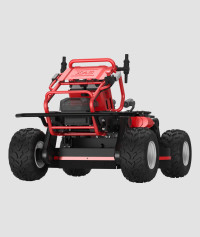A Customised Platform for Every Agricultural Mission
XAG R150 Unmanned Ground Vehicle is born for the next generation farming with unmanned systems. Powerful scalability and multiple operation modes, this is the first mass-produced agricultural robotic platform of its kind. From precision crop protection, field scouting to on-farm material delivery, it offers the industry-leading ground-based autonomous solutions that fit you the best.
XAG R150 UNMANNED GROUND VEHICLE
XAG R150 Unmanned Ground Vehicles is the world’s first mass-produced agricultural unmanned vehicle platform. The R150 is developed for unmanned farms, with multiple operation modes and powerful expansion functions; Based on the different agricultural needs, various functions such as precision plant protection, efficient spreading, intelligent mowing, transportation of agricultural materials, epidemic prevention can be achieved.
As the global population increases in the coming decades, there is a demand for new production processes that are more efficient, safer, and less destructive to the environment. Industries are working to fulfil this mission by developing intelligent innovations that carry on the workload. Producing sufficient food to meet the ever-growing demand for this rising population is a unique challenge to humanity. To succeed at this vital objective, we must build more efficient—yet sustainable—food production devices, farms, and infrastructures. To accomplish that objective, the precision farming concept—a set of methods and techniques to accurately manage variations in the field to increase crop productivity, business profitability, and ecosystem sustainability—has provided some excellent solutions. The agriculture world is making leaps and strides to implement the smart farm concept. One of the most vital elements that must be configured to meet the requirements of the new smart farms is the unmanned ground vehicles (UGV).
What Is an Unmanned Ground Vehicle?
As the global population increases in the coming decades, there is a demand for new production processes that are more efficient, safer, and less destructive to the environment. Industries are working to fulfil this mission by developing intelligent innovations that carry on the workload. Producing sufficient food to meet the ever-growing demand for this rising population is a unique challenge to humanity. To succeed at this vital objective, we must build more efficient—yet sustainable—food production devices, farms, and infrastructures. To accomplish that objective, the precision farming concept—a set of methods and techniques to accurately manage variations in the field to increase crop productivity, business profitability, and ecosystem sustainability—has provided some excellent solutions. The agriculture world is making leaps and strides to implement the smart farm concept. One of the most vital elements that must be configured to meet the requirements of the new smart farms is the unmanned ground vehicles (UGV).
Commercial Applications in Agriculture
Unmanned ground vehicles are one type of agricultural robot. Multiple civilian applications of UGVs are being implemented to automatic processes in manufacturing and production environments. For example, unmanned harvesting tractors can be operated around the clock, handling short windows for harvesting. UGVs are also used for spraying and thinning. They can also be used to monitor the health of crops and livestock. A fertiliser-spreading task can be performed autonomously if the appropriate implement tank has been filled with fertiliser and attached to a fueled autonomous tractor (UGV); the same concept applies to planting and spraying. However, tasks such as refilling, refuelling/recharging, implementing attachment, and crop unloading are performed manually. In addition, harvesting systems must offload the yield every time their collectors are full.
Automation of conventional vehicles
For the longest time, the tractor has been the central vehicle for executing most of the work required in a crop field. Equipped with the proper accessories, this machine can till, plant, fertilise, spray, haul, mow, and even harvest. Their adaptability to different tasks makes tractors a prime target for automation, enabling productivity increases, improving safety, and reducing operationally.








